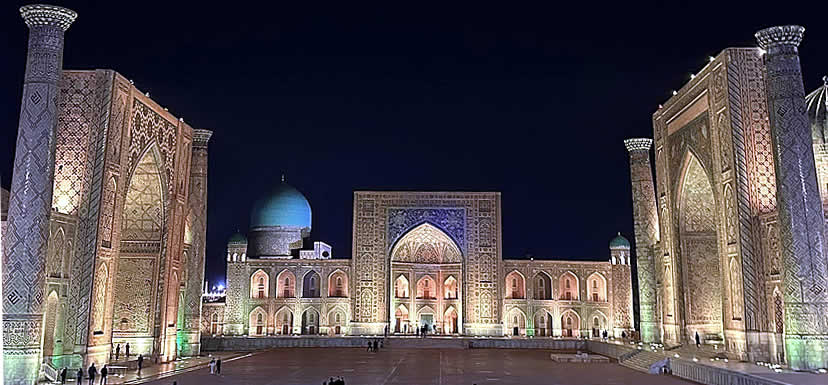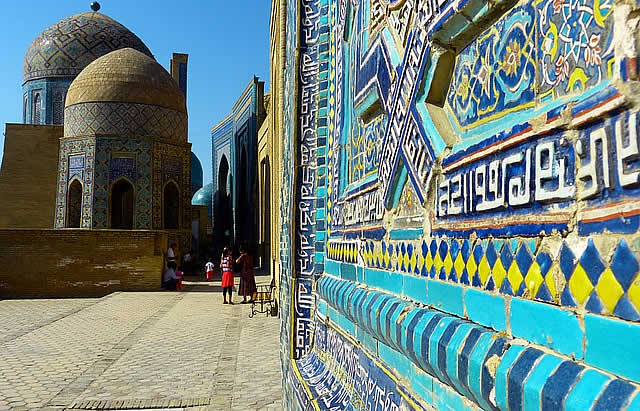Samarcand, one of the oldest cities in the world, is a hidden gem in the heart of Central Asia. Located in Uzbekistan, this historic city has been a crossroads of cultures, trade, and civilizations for over two thousand years. Samarkand has been a vital center along the legendary Silk Road.

History of Samarkand:
Ancient Origins Founded in the 7th century BC, Samarkand has been inhabited by various civilizations, including the Sogdians, an Iranian people who played a crucial role in trade along the Silk Road. The city was known as Maracanda during the time of Alexander the Great, who conquered it in 329 BC. After its conquest, Samarkand became an important center of Hellenistic culture.
The Islamic Era In the 8th century, Samarkand was conquered by the Arabs and became a center for the spread of Islam. During this period, the city flourished as an important center of Islamic learning and culture. The mosques, madrasas, and bazaars of Samarkand attracted scholars and merchants from across the Islamic world.
The Timurid Period The 14th century marked the peak of Samarkand’s greatness under the rule of Timur (Tamerlane), the great Turko-Mongol conqueror. Timur made Samarkand the capital of his vast empire and transformed it into one of the most splendid cities in the world. Under his reign, extraordinary monuments such as the Registan, the Bibi-Khanym Mosque, and the Gur-e Amir Mausoleum were built.
The Renaissance of Ulugh Beg In the 15th century, Samarkand continued to prosper under Timur’s grandson, Ulugh Beg, a renowned astronomer and mathematician. Ulugh Beg founded an observatory that became one of the most advanced of its time and attracted scholars from around the world. His madrasa, part of the Registan complex, became a world-famous center of learning.
Decline and Revival After the death of Ulugh Beg, Samarkand began to decline due to invasions and political changes. However, the city never completely lost its importance. During the Soviet period, Samarkand became part of Uzbekistan and began a process of modernization and restoration of its historic monuments.
Samarkand Today Today, Samarkand is a city that combines the charm of the past with the vitality of the present. Its historic monuments have been restored, and the city has become a popular tourist destination. Samarkand continues to be a symbol of cultural convergence and a testament to the rich history of Central Asia.
Conclusion The history of Samarkand is a testament to its resilience and ability to adapt to changes over the centuries. From an ancient crossroads of trade and cultures to a modern Uzbek city, Samarkand continues to enchant and inspire all who visit. A journey to Samarkand is a journey through history, an opportunity to discover the deep roots of one of the most fascinating cities in the world.

What to See in Samarkand:
- The Registan The Registan is the beating heart of Samarkand and one of the most spectacular architectural complexes in the world. Composed of three madrasas (Ulugh Beg, Sher-Dor, and Tilya-Kori), the Registan is famous for its facades decorated with intricate mosaics and colorful tiles. Walking through this square will make you feel like you’ve stepped back in time.
- The Bibi-Khanym Mosque Built in the 14th century by the order of Tamerlane, the Bibi-Khanym Mosque is one of the largest religious buildings of its time. Its imposing dome and detailed decorations are an extraordinary example of Islamic architecture.
- The Gur-e Amir Mausoleum This mausoleum is the burial place of Tamerlane and his family. With its blue dome and richly ornate interior decorations, the Gur-e Amir is an architectural masterpiece reflecting the grandeur of the Timurid Empire.
- The Siab Bazaar For an authentic experience, visit the Siab Bazaar, one of the oldest and most vibrant markets in Samarkand. Here you can find spices, dried fruits, textiles, and local crafts. It is the perfect place to immerse yourself in the local culture and shop for unique items.
- The Ulugh Beg Observatory Founded in the 15th century by Ulugh Beg, Tamerlane’s grandson, this observatory was one of the most advanced of its time. Today, you can visit the remains of the observatory and the adjacent museum to learn more about Ulugh Beg’s contributions to science and astronomy.
- The Afrosiab Museum Located on the ruins of the ancient city of Afrosiab, this museum offers an overview of the ancient history of Samarkand. Its collections include frescoes, ceramics, and other artifacts that tell the story of the city from pre-Islamic times to the medieval period.
- The Shah-i-Zinda Necropolis This complex of mausoleums is one of the most sacred places in Samarkand. Its tombs decorated with blue and green tiles are an extraordinary example of Timurid art. The necropolis is a place of pilgrimage and a site of great spiritual beauty.
Samarkand is a city that offers a unique mix of history, culture, and architectural beauty. Every corner of this city tells a story and offers visitors an unforgettable experience. Plan your trip to Samarkand and get ready to discover one of Central Asia’s most precious gems.

